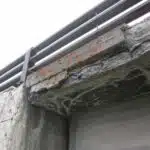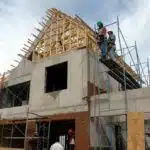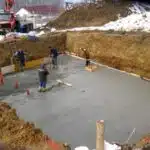As a patio cost estimator, understanding the factors that influence the cost of building a patio is critical. Patios are a great addition to any home, providing an outdoor living space for relaxation and entertainment. However, the cost of building a patio can vary greatly depending on several factors. In this article, we will explore the different elements that affect how much it costs to build a patio.
The cost of building a patio can depend on several factors, including size, materials used in construction, location, and design choices. While some homeowners may opt for a simple concrete slab as their patio flooring option, others may choose to install more luxurious options like natural stone or pavers. The choice of furniture and accessories also plays a significant role in determining the total budget for your patio project. In this article, we will delve into these factors in detail and provide you with an estimate of what you can expect to pay for your dream outdoor living space.
Size Of The Patio
Choosing dimensions for your patio is an important step in determining the overall cost of the project. The size of your patio will depend on a variety of factors, including the layout of your property and how you plan to use the space. A larger patio will generally cost more than a smaller one, as it requires more materials and labor to construct.
Custom shapes can also affect the cost of your patio. While a simple rectangular shape may be the most cost-effective option, adding curves or angles can create a unique look that enhances your outdoor living space. Keep in mind that custom shapes may require additional materials and labor, which can drive up the overall cost of your project.
Determining the right size and shape for your patio is a crucial part of creating an outdoor space that meets your needs and fits within your budget. Once you have chosen these dimensions, you can move on to selecting the materials used in construction.
Materials Used
You might have heard the age-old saying, “Money doesn’t grow on trees.” Unfortunately, neither do patios. While building a patio is an excellent addition to your backyard and an investment in your home’s value, it can be costly. The materials you choose to use significantly impact the cost of building a patio.
When it comes to patios, there are two primary material options: concrete or stone. Concrete is often the more affordable option, as it is readily available and easier to work with than stone. However, some homeowners may prefer the natural look of stone, despite its higher cost. Stone patios generally require more maintenance but offer a timeless and elegant appearance that many homeowners find appealing.
Another factor that impacts patio costs is choosing between natural or composite materials. Natural materials like wood or stone are typically more expensive than composite options like vinyl or plastic. However, natural materials offer durability and longevity that synthetic materials simply cannot match.
The choice of material will undoubtedly affect the overall price of your patio project. Still, it’s essential to remember that low-cost options aren’t always the best choice for long-term investments such as home improvement projects.
As you consider the different patio material options available to you, keep in mind that flooring type also plays a significant role in determining what costs come into play. In the next section, we’ll explore how different flooring types can impact overall project expenses and help you make an informed decision about which direction to take when building your dream outdoor space.
Type Of Flooring
Tiles are a great option for patios, as they come in a variety of shapes and sizes and can be used to create intricate and unique designs. The cost of tiles for a patio can vary depending on the size of the area and the quality of the tiles.
Pavers are another option for patios and are relatively easy to install. The cost of pavers for a patio will depend on the size of the area, the type of material used, and the desired design.
Concrete is one of the most affordable options for patios and can be used to create a variety of designs. The cost of concrete for a patio will depend on the size of the area, the desired design, and the quality of the concrete.
The cost of a tiled patio will vary depending on the size of the area, the quality of the tiles, and the complexity of the design.
The cost of a paver patio will vary depending on the size of the area, the type of material used, and the complexity of the design.
The cost of a concrete patio will depend on the size of the area, the desired design, and the quality of the concrete.
Tiles
When it comes to choosing the right type of flooring for your patio, tiles are an excellent option. Not only do they add a touch of elegance and sophistication, but they are also durable and low maintenance. Tiles come in a variety of patterns, ranging from simple geometric shapes to intricate designs that mimic natural stone or wood. This means that you can easily find a tile pattern that matches your personal style and complements the overall aesthetic of your home.
One important factor to consider when choosing tiles for your patio is their weather resistance. Since patios are exposed to the elements year-round, it’s crucial to select tiles that can withstand rain, snow, heat, and cold without cracking or fading. Look for tiles made from materials such as porcelain, ceramic, or natural stone like slate or granite. These materials have proven durability against extreme weather conditions and will ensure that your patio looks great for years to come.
In addition to their aesthetic appeal and weather resistance, tiles are also relatively easy to install compared to other types of flooring. However, the cost of tile installation can vary depending on factors such as the size of your patio, the complexity of the design pattern you choose, and whether you opt for professional installation or DIY. But rest assured that regardless of which route you take, investing in quality tiles for your patio will undoubtedly increase its value while providing a beautiful outdoor space for you and your loved ones to enjoy.
Pavers
When it comes to deciding on the best flooring for your patio, there are various options to consider. While tiles are a popular choice, another option worth considering is pavers. Pavers have become increasingly popular among homeowners due to their durability and versatility. They come in a wide range of materials such as concrete, brick, and natural stone, allowing you to create a unique look for your outdoor space.
Paver installation requires some careful consideration and planning. DIY installation may be possible for those with experience in construction; otherwise, hiring a professional is highly recommended. A pro can provide expert advice on design options and installation tips that ensure long-term durability without compromising aesthetics. While DIY installation may seem more cost-effective initially, mistakes can lead to additional expenses down the road.
Maintenance requirements for pavers are minimal but crucial for longevity. Regular cleaning is necessary to prevent dirt buildup that can cause discoloration or even damage over time. Sealing the pavers every two years is also essential in preventing staining from spills or weather conditions. Overall, while pavers require some upkeep, they are relatively low maintenance compared to other types of patio flooring.
Concrete
When it comes to choosing the best type of flooring for your patio, concrete is one option that stands out. Concrete is known for its durability and affordability, making it a popular choice among homeowners. It can withstand heavy foot traffic and extreme weather conditions, which makes it ideal for outdoor use. Additionally, concrete comes in various colors and finishes, allowing you to choose from a range of decorative options.
One benefit of using concrete as your patio flooring is that staining techniques can be applied to create unique designs and patterns. This allows you to customize your outdoor space according to your style preference. Staining also adds an extra layer of protection against wear and tear, ensuring long-term durability without sacrificing aesthetics. However, it’s important to note that staining should only be done by a professional to ensure consistent results.
Maintenance for concrete patios is relatively easy compared to other types of flooring. Regular cleaning with a gentle detergent and water can keep the surface clean and free from dirt buildup. Sealing the concrete every two years can also help prevent staining from spills or weather conditions. Overall, concrete is an excellent choice for those looking for a durable and low-maintenance option for their patio flooring needs.
Cost Of Labor
Moving on to the cost of labor for building a patio, it is worth noting that the type of flooring used plays a significant role in determining the final bill. However, other factors such as experience and location also affect labor costs. Experienced contractors tend to charge higher prices due to their expertise and quality workmanship. On the other hand, less experienced patio builders may charge lower rates but produce inferior results.
The location of the construction site also affects labor costs. Urban areas tend to have higher labor rates compared to rural areas, mostly because of the high living expenses associated with city life. Additionally, some states have higher minimum wage rates than others, which can translate into higher labor costs for homeowners looking to build patios.
When it comes to estimating the cost of labor for your patio project, it is essential to consider all these factors carefully. Doing so will help you make informed decisions when choosing a contractor and setting your budget accordingly. As an estimator, our team takes pride in providing accurate and competitive quotes that meet your needs while ensuring value for your money. In the next section, we’ll delve deeper into how location affects patio construction costs without using any conjunctive adverbs.
Location
Location is a crucial factor that affects the cost of a patio. Different regions have different factors that can influence the overall expense of building a patio. Some common factors include labor costs, material costs, and permits required for construction. Therefore, before deciding on the location of a patio, it is important to consider various factors that may affect the budget.
When comparing costs in different regions, it is essential to look at the local market conditions and labor rates. Construction costs vary depending on the region and city you are in. For instance, if you live in an urban area with high demand for construction services, you can expect to pay more for labor than you would in rural areas where labor supply is abundant. Additionally, some materials may be more expensive or scarce in certain regions than others.
Factors affecting location should be considered when estimating the cost of a patio project. These factors include zoning laws, soil type, drainage issues, topography of the land, and access to utilities such as water and electricity. By taking these into account when planning your patio project and selecting a location that meets your needs while minimizing potential problems or challenges associated with these factors, you can achieve savings on your overall construction cost.
Moving onto design choices…
Design Choices
Once the decision to install a patio has been made, it is important to consider design choices. One important aspect of patio design is color scheme. Choosing a color scheme for your patio can be an exciting opportunity to add personality and style to your outdoor space. Some popular color schemes include neutral colors such as beige or gray, bold colors like red or blue, or even a monochromatic scheme using different shades of the same color.
Another element to consider when designing your patio is furniture style. Depending on the intended use of the space, you may choose to incorporate comfortable seating options such as lounge chairs or sofas, or more formal dining sets for hosting guests. Additionally, adding accessories such as outdoor lighting fixtures, potted plants, and decorative cushions can help tie together the overall aesthetic of your patio.
Investing in quality materials and design choices can ultimately increase the value of your property while providing an enjoyable outdoor living space for years to come. In order to ensure that your new patio meets local building codes and regulations, obtaining necessary building permits is crucial. The next section will cover the steps required for obtaining these permits and ensuring that all codes are met during construction.
Building Permits And Codes
When it comes to designing a patio, there are several factors to consider. The design choices you make can ultimately impact the cost and timeline of your project. It’s important to have a clear idea of what you want before moving forward with any construction plans.
One common misconception about patio costs is that they are all the same. In reality, the cost of a patio can vary greatly depending on factors such as size, materials, and location. Another misconception is that building a patio is a quick and easy process. While some projects may be completed in a matter of days, others can take weeks or even months to complete.
Obtaining building permits and adhering to local codes is also an important part of the patio construction process. Failure to do so can result in fines and delays in the project timeline. It’s important to factor in the time and cost associated with obtaining permits when planning your patio project.
- Size: Consider how much space you need for entertaining or relaxing.
- Materials: Different materials come at different price points; do your research before deciding on which material to use.
- Location: Consider accessibility and whether any additional features like lighting or landscaping will be necessary.
Overall, understanding the various design choices and requirements needed for building a patio is crucial for an accurate estimate of cost and timeline. Don’t let common misconceptions mislead you – take into account all necessary steps when planning your project. Up next, we’ll discuss drainage considerations that should not be overlooked during the construction process.
Drainage Considerations
When planning to build a patio, it is essential to consider the terrain of the area where you intend to construct it. If the ground is sloped, it can pose challenges in terms of drainage. A slope may cause water to accumulate on the patio, which can lead to damage and mold growth. To address this problem, proper grading and drainage systems must be installed.
One option for ensuring proper drainage on a sloped terrain is through the use of French drains. These are trenches filled with gravel or rock that allow water to flow away from the patio’s surface and into a perforated pipe. The pipe then directs the water away from the area and prevents it from accumulating on or around the patio.
Apart from drainage considerations, waterproofing options are also crucial when building a patio. Waterproofing ensures that water does not seep through cracks and joints in the patio’s surface, which can lead to structural damage over time. Some popular waterproofing options include applying sealant coatings, using waterproof membranes, or installing drainage mats underneath pavers.
| Waterproofing Options | Pros | Cons |
|---|---|---|
| Sealant Coatings | Easy application; affordable | May require frequent reapplication |
| Waterproof Membranes | Durable; long-lasting protection | Expensive; difficult installation |
| Drainage Mats | Prevents water buildup; improves stability | Limited design options |
Considering these factors will help ensure that your patio remains functional and beautiful for years to come. In addition to having an attractive outdoor living space, you’ll also have peace of mind knowing that your investment is secure.
As you continue planning your patio project, another crucial aspect to consider is lighting and electrical work. Proper lighting adds ambiance and functionality while making your outdoor space safer and more inviting at night. In our next section, we’ll explore different lighting options for patios as well as important electrical considerations during construction.
Lighting And Electrical Work
Lighting and Electrical Work:
Lighting is a crucial component of any patio. Not only does it enhance the ambiance of the outdoor space, but it also provides safety and security. There are various options for patio lighting, ranging from traditional fixtures to smart home systems. Smart home systems offer energy-efficient solutions that can be controlled remotely through a smartphone or tablet.
When it comes to electrical work, it is important to hire a licensed electrician for any wiring needed for lighting or other electrical components. This ensures that everything is up to code and safe for use. Additionally, incorporating energy-efficient features such as LED lights or solar-powered fixtures can help reduce energy costs in the long run.
Investing in smart home technology and energy-efficient options for your patio’s lighting and electrical needs not only benefits the environment but also saves you money on utility bills. Incorporating these features enhances the overall functionality and beauty of your outdoor space while providing a safe and secure environment for you and your guests.
Transition: Now that we have covered the importance of lighting and electrical work, let’s move onto another essential aspect of creating an inviting patio – furniture and accessories.
Furniture And Accessories
While lighting and electrical work are essential for any outdoor living space, the right patio furniture and accessories can take your backyard to the next level. Patio furniture comes in a wide range of styles and materials, from classic wrought iron to modern synthetic wicker. The most popular options include dining sets, lounge chairs, and sectionals that allow you to create a cohesive look throughout your outdoor space.
When it comes to outdoor accessories, there are must-haves and nice-to-haves. Must-haves include items like umbrellas for shade, outdoor rugs to delineate seating areas, and storage solutions for cushions and other items that need protection from the elements. Nice-to-haves might include fire pits or water features that add ambiance to your patio area.
Incorporating the right patio furniture and accessories into your design can greatly enhance your outdoor living experience. From choosing the right style to adding functional elements like storage and shade, these pieces help make your patio feel like an extension of your home. In the next section, we’ll discuss the final step in creating an outdoor oasis: landscaping and plantings.
Landscaping And Plantings
When planning a patio, it is important to consider the overall design and how it will complement your landscaping and plant selection. The type of plants you choose can greatly impact the look and feel of your outdoor space. For example, if you prefer a more natural and rustic style, incorporating native plants and wildflowers can create a beautiful and low-maintenance landscape.
When selecting plants for your patio area, it is important to consider their specific needs for sunlight, water, and soil conditions. Some popular options for patio landscaping include shrubs, perennials, ornamental grasses, and even small trees. It is also important to consider the mature size of each plant to ensure they do not outgrow their designated space.
Once your patio and landscaping are complete, it is important to establish a maintenance schedule to keep everything looking its best. This may include regular watering, fertilizing, pruning, and pest control measures. Consider hiring a professional landscaper or gardener to assist with ongoing maintenance tasks if you are short on time or lack gardening experience. By investing in proper maintenance now, you can enjoy a beautiful and functional outdoor space for years to come.
As you plan your patio project, it is essential to factor in ongoing maintenance costs in addition to the initial installation expenses. These costs may vary depending on the size of your outdoor space and the types of plants you have selected. However, by establishing a regular maintenance schedule early on, you can help prevent larger issues from arising down the road that could result in costly repairs or replacement expenses.
Maintenance Costs
Symbolically speaking, a patio is like a crown jewel for your outdoor living space. It can significantly enhance the aesthetics of your home and increase its resale value. However, like any other investment, it requires maintenance to keep it looking beautiful and functional for years to come.
Hiring professionals for patio maintenance can be an excellent option if you don’t have the time or expertise to do it yourself. Professional patio maintenance services usually include pressure washing, resealing, and repairing cracks or damages. The cost of hiring professionals varies depending on the size, type of material used, and location of your patio. On average, you can expect to pay between $500-$1,000 per year for regular maintenance services.
If you’re someone who enjoys DIY projects and has some experience with outdoor home improvement tasks, then maintaining your patio yourself can be a viable option. DIY options include cleaning with mild detergents or specialized cleaning solutions, resealing every 2-3 years with a sealant appropriate for your patio’s material type and ensuring that water drains away from the house rather than pooling on the surface. However, keep in mind that if done incorrectly, DIY maintenance can potentially damage your patio further and will cost more in repairs in the long run.
In summary, whether you choose to hire professionals or maintain it yourself depends largely on personal preference and skill level. While hiring professionals may require a higher initial investment than doing it yourself, it guarantees top-notch results without risking further damage to your patio. On the other hand, opting for DIY options saves money but requires more time and effort on your part while also increasing the risk of mistakes being made during maintenance. In our next section we will explore both options in greater detail: DIY vs Hiring A Professional – which is right for you?
Diy Vs. Hiring A Professional
Maintaining your patio is crucial to prolonging its lifespan and minimizing future costs. Regular cleaning and sealing can prevent the growth of weeds, moss, and algae that could damage the surface. It’s also important to check for any cracks or chips in the concrete or pavers, as these can lead to tripping hazards or further deterioration. Replacing damaged materials promptly will save you money in the long run.
When it comes to building a patio, you may be wondering if you should hire a professional or take on the project yourself. While DIY might seem like a more cost-effective option, there are several challenges to consider. Firstly, you need to have the necessary tools and skills to complete the job safely and efficiently. Secondly, you’ll need to obtain any required permits and ensure that your design meets local regulations. Finally, there’s always a risk of mistakes that could lead to additional expenses down the line.
On the other hand, hiring a professional has many benefits. They have years of experience and training in patio installation and can provide valuable advice on design options and material choices. Moreover, professionals have access to specialized equipment that ensures precise measurements and accurate cuts. When working with a contractor, you can expect high-quality workmanship that meets industry standards. In addition, many professionals offer warranties that protect your investment from unexpected repairs or replacements.
Financing Options
- Patios can range in cost depending on the size and complexity of the project.
- Financing options for patio projects may include using credit cards, home equity loans, or personal loans.
- Credit card financing may allow for a flexible payment period with the potential for rewards and cash-back benefits.
- Home equity loans can offer lower interest rates with a longer repayment period, but the borrower must have equity in their home.
- Personal loans can also be used to finance patio projects with the potential for lower interest rates and flexible repayment terms.
- For more information about financing options for patio projects, contact a financial institution or patio cost estimator.
Credit Cards
When considering financing options for your patio, it’s important to take a closer look at credit cards. One of the benefits of using a credit card is maximizing rewards. Many credit cards offer cash back or points that can be redeemed for travel or merchandise. By using your credit card to make purchases for your patio, you can earn rewards that can be used towards future expenses such as furniture or outdoor decor.
However, it’s also important to consider managing debt when using a credit card to finance your patio. Interest rates on credit cards can be high, and if not managed properly, can lead to significant debt. To avoid this, it’s recommended to pay off the balance in full each month or use a card with a low interest rate. It’s also important to create a budget and stick to it when using a credit card for large purchases like a patio.
In summary, while credit cards can offer benefits like maximizing rewards, it’s crucial to keep in mind managing debt when using them as a financing option for your patio project. By being mindful of interest rates and creating and sticking to a budget, you can successfully use a credit card without accumulating unnecessary debt.
Home Equity Loans
Another financing option to consider for your patio project is a home equity loan. This type of loan allows you to borrow against the equity in your home, using it as collateral. One of the benefits of a home equity loan is that interest rates are typically lower than credit cards or personal loans. Additionally, the interest paid on a home equity loan may be tax-deductible.
However, there are also some cons to consider when it comes to using a home equity loan for financing your patio. One potential downside is that eligibility requirements can be strict. You must have significant equity in your home and a good credit score to qualify. Another con is that if you default on the loan, you could potentially lose your home.
Overall, whether a home equity loan is right for you depends on your individual financial situation and goals. It’s important to weigh the pros and cons carefully before making any decisions regarding financing for your patio project.
Personal Loans
Moving on to another financing option, personal loans can also be a viable choice for funding your patio project. Personal loans are unsecured loans, which means that you won’t need to offer collateral such as your home or car. Therefore, they may be easier to qualify for than home equity loans. Additionally, personal loan options are widely available from various financial institutions and lenders.
However, it’s important to understand that personal loans often come with higher interest rates than other forms of financing such as home equity loans or secured loans. Also, the repayment strategies for personal loans differ from those of other types of financing options. Personal loan payments are typically fixed and require monthly payments until the loan is fully repaid. It’s crucial to ensure that you have a solid plan in place for making timely repayments before taking out a personal loan.
In conclusion, when it comes to financing your patio project, there are several options available depending on your individual financial situation and goals. Personal loan options offer flexibility in terms of qualification requirements and availability, but also come with higher interest rates and fixed repayment strategies. Carefully weighing the pros and cons of each option will help you make an informed decision about how best to fund your patio project while staying within your budget constraints.
Budgeting Tips And Tricks
A well-designed patio can enhance the beauty and functionality of your outdoor space, but it comes at a cost. The average cost of patios ranges between $800 and $4,000 for a DIY project, while professional installation may cost upwards of $10,000. The final cost depends on various factors including the size, materials used, and complexity of design.
DIY vs Professional is the first decision to make when budgeting for a patio. A DIY project can save you money but requires time and effort. It involves designing the patio, purchasing materials, preparing the site, and installing the patio yourself. On the other hand, hiring a professional means that you will pay more but get quality workmanship without having to lift a finger.
Cost Cutting Strategies can help you save money on your patio project. One way is to use affordable materials such as concrete pavers or gravel instead of expensive natural stones or bricks. Another strategy is to simplify the design by opting for a basic shape rather than intricate patterns or curves. Additionally, sourcing materials from local suppliers can help reduce transportation costs.
In summary, Budgeting Tips and Tricks are essential when planning for a patio project. Whether you choose to DIY or hire professionals, there are ways to cut costs without compromising quality. By using affordable materials and simplifying designs, you can create an inviting outdoor space without breaking the bank.
Conclusion
The cost of building a patio can vary greatly depending on several factors, including the size of the patio, materials used, type of flooring, cost of labor, location and maintenance costs. It is important to consider all of these factors when estimating the total cost of your patio project.
When it comes to budgeting for a new patio, it’s important to keep in mind that this is an investment in your home that will add value and enjoyment for years to come. Just like planting a garden requires careful planning and attention to detail, building a patio requires careful consideration of all aspects involved.
In conclusion, building a new patio can be compared to laying the foundation for a beautiful garden. With proper planning and budgeting, you can create an outdoor space that will provide enjoyment for years to come. Whether you choose to hire a professional or tackle the project yourself, it’s important to carefully consider all aspects involved in order to ensure success. Take advantage of financing options and budgeting tips and tricks in order to make your dream patio a reality.
Image Credits
- “Patio” by kevin dooley (featured)





























